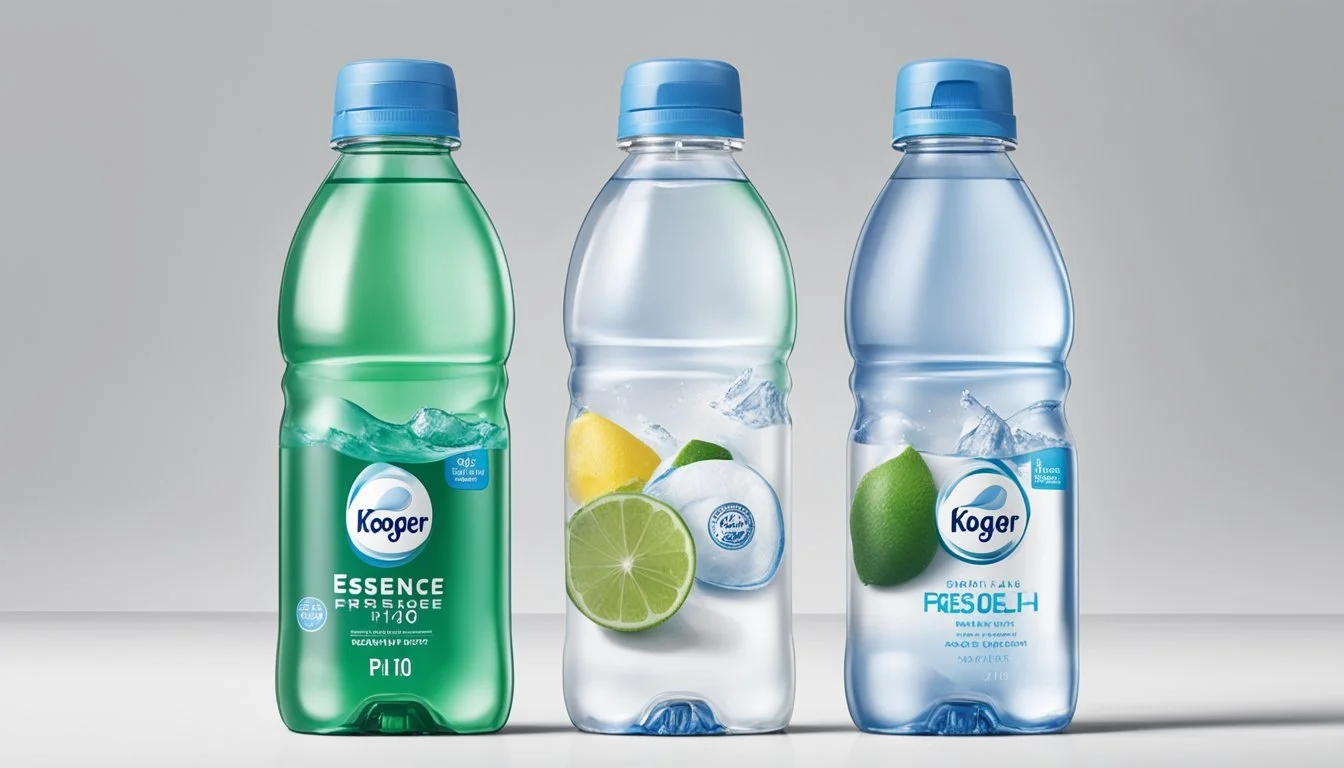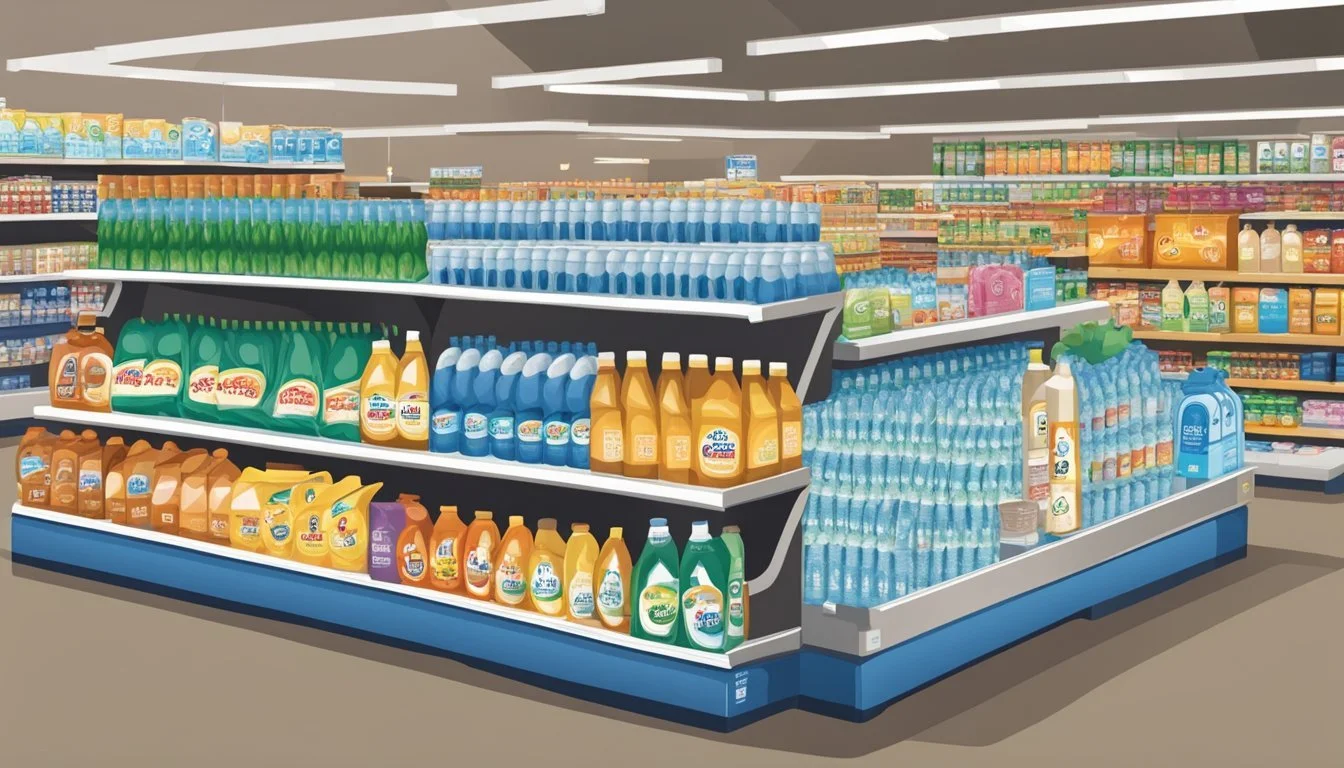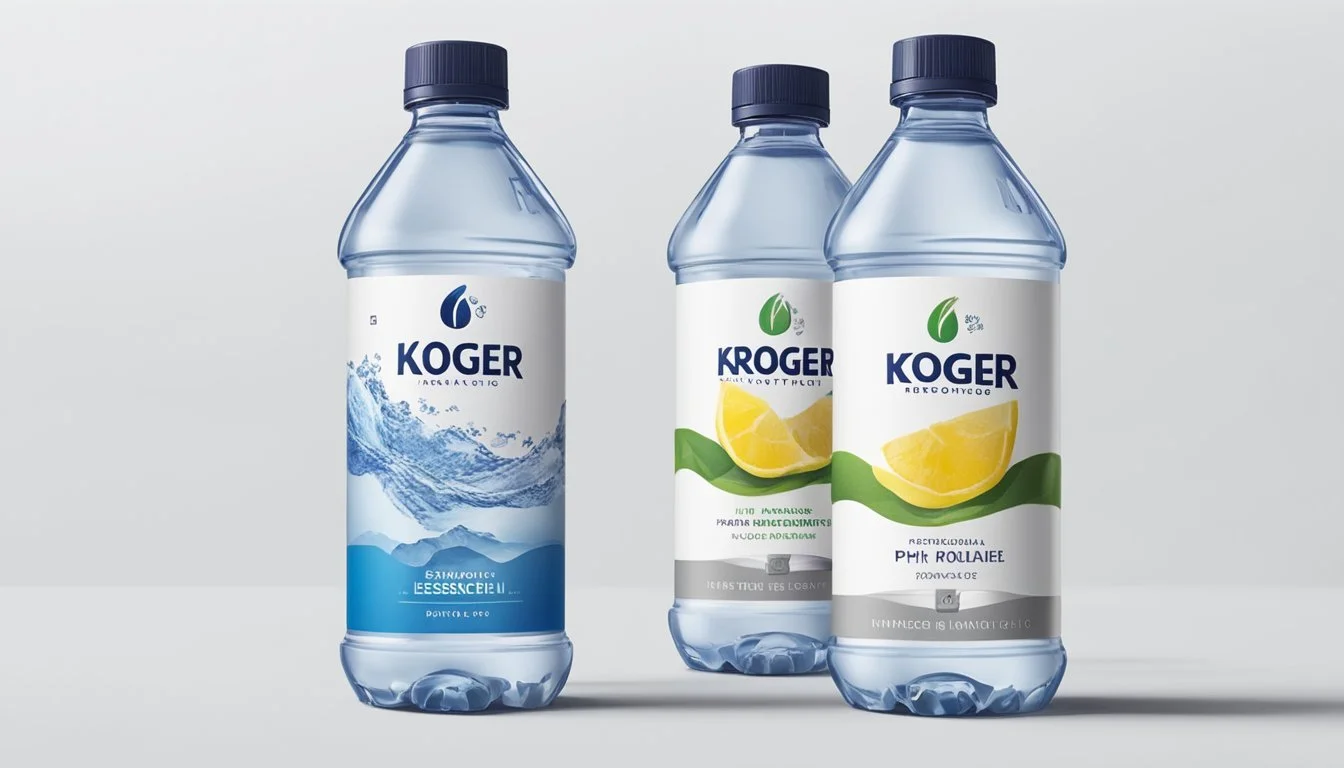Kroger vs. Essence pH10
Which Bottled Water is Better for Your Health?
When choosing between Kroger bottled water and Essence pH10, consumers often focus on factors such as pH levels, mineral content, and overall taste. Essence pH10 stands out for its well-balanced pH level of 10, which is significantly higher than the typical range found in most bottled waters, including Kroger. Known for its alkaline properties, Essence pH10 promotes hydration and boasts a unique, refreshing taste that appeals to many health-conscious individuals.
Kroger bottled water, on the other hand, offers a more standard pH level and is widely available, making it a convenient option for everyday hydration. Although it adheres to FDA regulations ensuring safety and quality, it lacks the distinctive attributes that make Essence pH10 a favorite among those seeking enhanced hydration benefits.
When comparing these two brands, it's clear that both have their strengths. Kroger provides an affordable and accessible choice for many, while Essence pH10 offers a premium experience with its higher pH level.
Background on Kroger and Essentia Water Brands
Kroger and Essentia Water brands cater to different segments in the bottled water market. Kroger emphasizes affordability and accessibility, while Essentia focuses on health benefits with its alkaline water.
Kroger's Place in the Water Market
Kroger's bottled water is a staple for many consumers due to its wide availability and cost-effectiveness. Kroger adheres to FDA regulations, ensuring safety and quality standards.
Kroger aims to meet everyday hydration needs, offering various package sizes from individual bottles to bulk packs. Many of their bottles are BPA-free, addressing health concerns.
Environmental impact is a notable issue with Kroger due to plastic waste. Still, they undertake recycling initiatives. Despite some concerns over microplastics, Kroger remains a trusted choice for basic hydration needs.
Essentia Water: Quality and Positioning
Essentia Water appeals to the health-conscious segment with its premium ionized hydration products. With a pH level of 9.5 or higher, Essentia positions itself as a superior alkaline water brand.
Essentia markets its products emphasizing hydration and wellness benefits, gaining traction among fitness enthusiasts. The brand highlights its purity and mineral content, enhancing its appeal.
Essentia's higher price point reflects its premium positioning. The brand is often considered a lifestyle choice, differentiating itself by targeting consumers looking for specific health benefits in their water.
Essentia's strategic branding has made it a significant player in the bottled water market.
Water Quality and Safety Concerns
When choosing between Kroger and Essence pH10 bottled water, it is vital to consider water quality and safety. This involves analyzing contaminants, regulatory compliance, and testing methods.
Evaluating Bottled Water Quality
Water quality in bottled water depends on the source and treatment processes. Kroger bottled water must meet FDA standards, ensuring it adheres to safety and quality benchmarks. Essence pH10, marketed for its high pH balance, also undergoes careful processing to maintain its advertised properties.
Consumer Reports testing found varying contaminants in different brands, including microplastics and PFAS chemicals. Analyzing the company's water quality reports can offer insights into the specific contaminants present in each brand.
Regulations and Compliance
Bottled water in the United States must comply with both EPA and FDA regulations. The EPA sets standards for tap water, and the FDA ensures bottled water meets similar safety and quality criteria. Compliance with these regulations includes adhering to legal limits for contaminants like lead, arsenic, and bacteria.
Kroger and Essence pH10 are required to publish annual quality reports detailing their adherence to these standards. This adds a layer of transparency, allowing consumers to verify the water's safety and quality directly from the provided documentation.
Safety Measures and Testing
Safety measures for bottled water include various filtration and purification processes. These might involve reverse osmosis, ozonation, or the addition of minerals. Kroger and Essence employ such methods to ensure their water is safe for consumption.
Regular testing is crucial. Brands typically conduct tests to detect contaminants like microplastics, caffeine, and pharmaceutical residues. The presence of toxins such as PFAS chemicals can raise health concerns. For Kroger and Essence pH10, ensuring rigorous and frequent testing can minimize potential risks to consumers.
Sourcing and Purification Processes
Kroger and Essentia pH10 differ significantly in their water sources and purification methods, impacting the quality and characteristics of the water consumers drink.
Understanding Water Sources
Kroger sources its bottled water from various municipal water supplies and wells. These sources are selected based on their compliance with the Environmental Protection Agency (EPA) standards.
Essentia, on the other hand, sources its water from municipal sources and sometimes underground wells but focuses on sourcing water that is initially low in total dissolved solids (TDS).
Essentia’s sourcing strategy prioritizes water that is easier to purify and potentially better-tasting. Both companies use these sources to create a reliable product for their consumers, but the differences in sources can influence the final product's purity and taste.
The Purification and Filtration Landscape
Kroger uses a multi-step purification process, typically involving carbon filtration, reverse osmosis, and ultraviolet light treatments. These steps are designed to remove contaminants and improve taste, ensuring the water meets high safety standards.
Essentia employs a more advanced and specialized purification process. This process includes microfiltration, reverse osmosis, and UV light exposure, followed by re-mineralization to enhance alkalinity and achieve a higher pH level of 9.5.
Essentia's ionization process also claims to improve hydration efficiency. Such meticulous filtration and purification processes set Essentia apart by offering water that is not only clean but also enhanced, aiming to provide more health benefits compared to standard purified water.
pH Levels and Alkalinity
pH levels and alkalinity are crucial factors in determining the quality of bottled water. This section will explore the science behind pH in bottled water and the impact of alkalinity on health.
The Science of pH in Bottled Water
pH is a measure of how acidic or alkaline a substance is. The pH scale ranges from 0 to 14. A pH of 7 is neutral, below 7 is acidic, and above 7 is alkaline.
The optimal pH range for drinking water falls between 6.5 and 8.5.
Kroger water typically has a neutral to slightly acidic pH, usually around 7. In contrast, Essence pH10 usually offers a higher pH, often around 10.
Kroger Water:
pH: ~7
Alkalinity: Neutral to slightly acidic
Essence pH10:
pH: ~10
Alkalinity: High
Impact of Alkalinity on Health
Alkaline water enthusiasts claim that water with a higher pH offers several health benefits, including improving hydration and balancing body pH. While these claims have mixed scientific support, alkaline water is thought to neutralize excess acidity in the body.
Potential benefits of alkaline water:
May boost hydration
Can neutralize stomach acid, potentially helping with acid reflux
Some sources suggest it may enhance immune function
However, excessively high pH levels can also pose risks. Drinking water with a very high pH may disrupt the body's natural pH balance and contribute to certain health issues. It's essential to consume water within a safe and beneficial pH range.
Taste Profile and Consumer Preferences
Essentia pH1010 and Kroger bottled water differ notably in their taste profiles and consumer reception. Analyzing their taste characteristics and consumer feedback provides insight into their relative appeal.
Exploring the Taste of Kroger and Essentia
Kroger bottled water has a neutral taste, which many consumers find to be refreshingly simple. The water is sourced from municipal taps and filtered through a rigorous purification process. This results in a clean, almost blank taste that serves as a versatile beverage.
Essentia pH1010 stands out with its alkaline nature, boasting a pH of 9.5 or higher. This makes its taste distinctly smoother with a noticeable softness. The additional electrolytes enhance its profile, making it preferred by those sensitive to metallic or acidic tastes.
Water sommeliers often highlight Essentia's unique characteristics. They commend its rich yet gentle texture, which appeals to a segment of the health-conscious market. Kroger’s no-frills profile, however, keeps it a staple for everyday hydration without overwhelming the palate.
Consumer Reviews and Expert Opinions
Consumers have varying preferences between Kroger and Essentia. Kroger is praised for its affordability and accessibility. Many appreciate its straightforward taste, which doesn't interfere with other flavors, making it an excellent choice for mixing with other beverages.
Essentia pH1010, on the other hand, receives high marks for its smooth and refreshing quality. Reviewers often mention the hydration benefits they perceive, attributing it to the higher pH and electrolytes. It's frequently recommended by fitness enthusiasts and those who value premium water.
Experts echo these sentiments. Water sommeliers and taste testers frequently cite Essentia's superior mouthfeel and balanced taste. Kroger, while not winning awards for flavor, remains a reliable, budget-friendly option that meets basic hydration needs without the premium price tag.
Environmental Responsibility and Packaging
Consumer concerns about environmental impact and health safety are increasingly shaping the bottled water industry. Both Kroger and Essence pH10 have implemented practices to address these issues, focusing on eco-friendly bottling methods and materials.
Eco-Friendly Practices in Bottling
Kroger and Essence pH10 have made strides in reducing their environmental footprint through various initiatives. Kroger participates in Environmental, Social, and Governance (ESG) reporting, emphasizing its commitment to sustainability. The company has established goals for reducing plastic waste and improving recycling efforts.
Essence pH10, on the other hand, promotes its use of energy-efficient production processes. They highlight their efforts to minimize CO2 emissions during bottling and transport. Both brands aim to balance consumer demand with environmental responsibility by focusing on sustainable practices and transparency.
Bottle Materials and Consumer Health
The choice of bottle materials is crucial for both environmental and health reasons. Kroger's bottled water often uses BPA-free plastics, addressing consumer concerns about chemicals leaching into water. They also explore biodegradable and recyclable options to reduce plastic waste.
Essence pH10 takes pride in utilizing high-quality, BPA-free bottles. They emphasize testing for contaminants like microplastics to ensure safer drinking water. By opting for safer materials, both brands not only protect consumer health but also contribute to reducing environmental impacts associated with traditional plastic bottles.
Market Presence and Availability
Kroger and Essence pH10 are both prominent players in the bottled water market, but their market presence and availability differ significantly, reflecting their distinct business models and distribution strategies.
Retail Distribution of Kroger and Essentia
Kroger bottled water is widely available across the United States, primarily in Kroger-owned stores. These include chains such as Kroger, Ralphs, Fred Meyer, and King Soopers. The extensive retail network makes Kroger water easy to find for many consumers.
Essentia, on the other hand, is available in a variety of retail locations beyond grocery stores. Its distribution network includes gyms, specialty stores, and major online retailers like Amazon. This wider range of availability has helped Essentia gain a strong foothold in the market, appealing to health-conscious consumers looking for premium water options.
Geographical Footprint and Supply Chain
Kroger's water products are primarily distributed within the United States, with a strong presence in states where Kroger's stores operate. This regional focus ensures reliable supply chains and consistent quality control across its products.
Essentia boasts a broader geographical footprint, with availability not only in the United States but also in Canada. This international reach is facilitated by the fact that Essentia's products are frequently stocked by global retail giants. Membership in the International Bottled Water Association ensures that Essentia adheres to stringent standards and maintains a robust supply chain network, enhancing its reliability and market presence.
Essentia's sourcing from pristine natural springs further supports its supply chain, differentiating it from more regionally focused brands like Kroger.
Comparative Analysis
This section evaluates Kroger and Essentia pH1010 in terms of purity, quality, and market ranking. Specific attributes like filtering methods, pH levels, and industry reputation are discussed.
Direct Comparison: Kroger vs. Essentia
Purity and Quality:
Kroger bottled water adheres to FDA regulations, ensuring it meets safety and quality standards. Concerns about contaminants like microplastics and BPA exist, though many bottles are now BPA-free.
Essentia undergoes advanced purification methods, including micro-filters, reverse osmosis, and ultraviolet exposure. Its water is 99.9% pure, with added electrolytes, and ionized to achieve an alkaline pH of 9.5 or higher.
Taste and Consumer Feedback:
Kroger water is praised for reliability but may have a plastic aftertaste. In contrast, Essentia is valued for its consistent taste and higher alkalinity, appealing to those looking for added health benefits.
Ranking within the Bottled Water Industry
Market Position:
Essentia competes with premium alkaline brands like Fiji, Evian, and Voss. Its high pH and purity place it among top choices. In reviews, Essentia often excels, though its price may be a barrier.
Kroger, a more budget-friendly option, competes with mid-range brands like Dasani, Aquafina, and Poland Spring. While not at the top of rankings, it serves a broad market segment well.
Environmental Considerations:
Both brands use plastic bottles, contributing to environmental concerns. Essentia's marketing focuses on health benefits, while Kroger emphasizes affordability and availability. Brands like Just Water and Boxed Water offer more eco-friendly packaging options, appealing to environmentally conscious consumers.
Consumer Perception:
Essentia scores higher for premium quality and health benefits. Kroger provides accessible, compliant bottled water, suitable for daily use without the premium price tag.
Final Thoughts on Kroger and Essentia Water Brands
Kroger Bottled Water adheres to FDA regulations, ensuring safety and quality standards. Despite being a cost-effective choice, the environmental impact of plastic bottles and potential presence of contaminants like microplastics can be concerns for some consumers.
Essentia Water has positioned itself as a premium alkaline water brand with a distinct pH of 9.5 or higher.
Health-conscious individuals may appreciate the ionized hydration and potential benefits. The premium pricing of Essentia reflects its targeted branding and perceived health benefits.
Comparison Table:
Feature Kroger Bottled Water Essentia Water Price Cost-effective Premium pH Level Neutral 9.5 or higher FDA Regulations Adheres Adheres Environmental Impact Concerns over plastic Still uses plastic Contaminants Possible microplastics Marketed as pure Consumer Appeal General Health-conscious
Consumers seeking affordability and general use may lean towards Kroger. In contrast, those prioritizing specific health benefits and willing to spend more may prefer Essentia.
Both brands meet industry standards but cater to different market segments. Personal preferences and priorities will ultimately influence the choice between these two options.
More About Kroger
Kroger vs Kirkland Signature: Which Bottled Water is Better?
Kroger vs Richard's Rainwater: Which Bottled Water is Better?
Mountain Valley Spring Water vs Kroger: Which Bottled Water is Better?
Whole Foods Italian Still Mineral water vs Kroger: Which Bottled Water is Better?
More About Essence pH10
Aqua Carpatica vs Essence pH10: Which Bottled Water is Better?
Cascade Mountain vs Essence pH10: Which Bottled Water is Better?
Core Hydration vs Essence pH10: Which Bottled Water is Better?
Crystal Geyser vs Essence pH10: Which Bottled Water is Better?
Crystal Lake vs Essence pH10: Which Bottled Water is Better?
Hawaii Volcanic vs Essence pH10: Which Bottled Water is Better?
Hawaiian Springs vs Essence pH10: Which Bottled Water is Better?
Ice Mountain vs Essence pH10: Which Bottled Water is Better?
Icelandic Glacial vs Essence pH10: Which Bottled Water is Better?
Kirkland Signature vs Essence pH10: Which Bottled Water is Better?
Liquid Death vs Essence pH10: Which Bottled Water is Better?
Mountain Valley Spring Water vs Essence pH10: Which Bottled Water is Better?
Nestle Pure Life vs Essence pH10: Which Bottled Water is Better?
Poland Spring vs Essence pH10: Which Bottled Water is Better?
Proud Source vs Essence pH10: Which Bottled Water is Better?
Purely Sedona vs Essence pH10: Which Bottled Water is Better?
Richard's Rainwater vs Essence pH10: Which Bottled Water is Better?
San Pellegrino vs Essence pH10: Which Bottled Water is Better?
Simple Truth vs Essence pH10: Which Bottled Water is Better?
Solan de Cabras vs Essence pH10: Which Bottled Water is Better?
Talking Rain AQA vs Essence pH10: Which Bottled Water is Better?
Whole Foods 365 vs Essence pH10: Which Bottled Water is Better?
Whole Foods Italian Still Mineral water vs Essence pH10: Which Bottled Water is Better?








